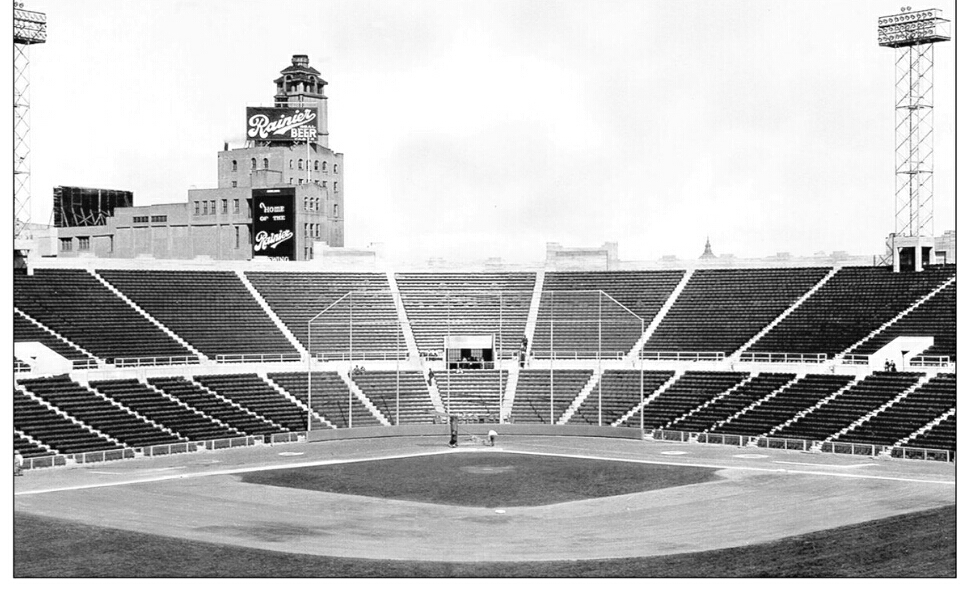
Though I’m three months late posting this piece about this anniversary in September, I think it’s very worthy of recognition. September 20, 2019 marked the 60th anniversary of the final baseball game played at Seals Stadium. On a personal note, Seals Stadium was where I saw my first major league game. It was in April 1958 that my father and paternal grandfather took me to my first Giants game when I was 6 years old. It’s been a lifelong passionate love affair with the great game of baseball ever since for me.
In this article I will cover the building of and history of the first modern ballpark built in San Francisco and describe the final series played there. Then I will touch on the demolition of the proud little green ballpark at 16th & Bryant Streets.
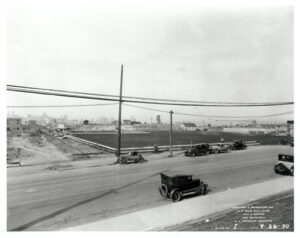
When it opened Herbert Hoover was in the White House, the Great Depression was ravaging the country, the finishing touches were being put on the Empire State Building, the sleepy desert town of Las Vegas legalized gambling and a loaf of bread would set you back 8 cents. I’m talking about San Francisco’s brand new ballpark, Seals Stadium and the year was 1931. Seals Stadium was state-of-the-art in every way. It cost over a million dollars and featured lights four years before the first major league park, a public address system so umpires didn’t need a megaphone and modern steel and concrete construction.
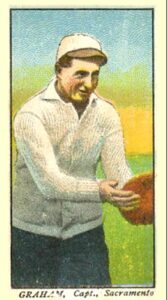
Seals majority owner Charles “Uncle Charlie” Graham, The Father of West Coast Baseball, formed a corporation with his fellow Seals co-owners; Dr Charles Strub, a San Francisco dentist, and George “Putty” Putnam, a Sacramento newspaperman, to build Seals Stadium. The deal was signed early in 1929 before the stock market crash triggered the Great Depression. By the time the stadium was completed, the depression was in full swing.
There was very hard times during The Depression and numerous times the Seals nearly failed. The sale of such future Hall of Famers like Joe DiMaggio and Vernon “Lefty” Gomez by “Uncle Charlie” Graham to the New York Yankees barely kept the Seals from going under.
One amazing coincidence of note, Seals Stadium was built on the site of an old pioneer Gold Rush claim of 1848 called … Home Plate Mine! Gold was mined at the corner of 16th & Bryant Streets long before runs crossed a baseball home plate. Home Plate Mine became an early nickname of Seals Stadium.
Another unique feature of Seals Stadium was the three clubhouses it was designed with. This was necessitated because the new stadium was shared by the two San Francisco Pacific Coast League teams, the Seals and the Mission Reds (named for the Mission District). The Mission Reds moved to Los Angeles and became the Hollywood Stars in 1938.
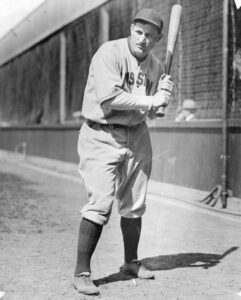

Seals Stadium opened officially on April 7th 1931 when the season opener was played. Ty Cobb participated in the opening ceremonies. The Georgia Peach took a swing at an intentionally unreachable blooper pitch by San Francisco mayor Angelo Rossi – the crowd howled in delight. Despite the depression, a standing-room only crowd approaching 25,000 watched the Seals shut out the Portland Beavers 8-0. On the front page of The Chronicle’s Sporting Green the next day the San Francisco Chronicle’s Ed R. Hughes described the large crowd like this, “biggest that ever looked at a ball game in San Francisco.”
There followed twenty-seven years of excellent Seals baseball. Many baseball observers considered the Pacific Coast League as equal to the major leagues in talent and quality of play. There even was an idea by some to make the Pacific Coast League the third major league.
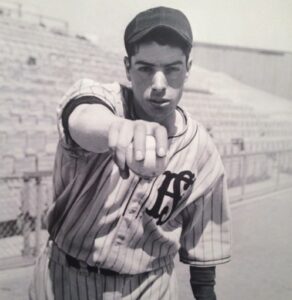
In their 55 year history, the Seals won the Pacific Coast League flag 13 times. These future major league stars led the Seals to those pennants; Hall of Famers Paul “Big Poison” Waner, Lloyd “Little Poison” Waner, Joe DiMaggio, Earl Averill, Harry Heilmann, Tony Lazzeri, Vernon “Lefty” Gomez – as well as Vince and Dominic DiMaggio, Frank Crosetti, Ferris Fain and Albie Pearson.
The San Francisco Seals came to an end when San Francisco mayor George Christopher lured the New York Giants owner Horace Stoneham to move the franchise to San Francisco in 1958. The Seals won the Pacific Coast League pennant in their final season of 1957. The San Francisco Giants played in Seals Stadium two years while Candlestick Park was being built. The remainder of this piece will describe the final series played in Seals Stadium.

Twenty-nine years of high-quality professional baseball came to an ignominious close on Sunday September 20, 1959 at Seals Stadium when the Giants lost the final home game of the season to their longtime despised rivals, the Dodgers. The weekend series had opened with the Giants leading the National League by two games with only eight to play. The Giants had held tenaciously to first place in the National League since August 5th. Hopes were soaring in The City that the 1959 World Series would be held in the “almost completed” Candlestick Park.
A sweep by the Giants in the three game weekend series would virtually eliminate the Dodgers. Fresh off a two-game split with the two-time defending National League champions Milwaukee Braves, the hometown nine were two games up on both the Dodgers and Braves. Instead the weekend turned into a mournful wake to close out the little ballpark at 16th & Bryant Streets.
The final series in Seals Stadium was not a storybook ending in any way. The Friday night game was postponed when a freak record-setting mid-September storm hit Northern California. The strong storm dropped 2 inches of rain on San Francisco! Embarrassingly, because it doesn’t rain in San Francisco in September (right?) – there was no tarp put down on the infield at Seals Stadium!
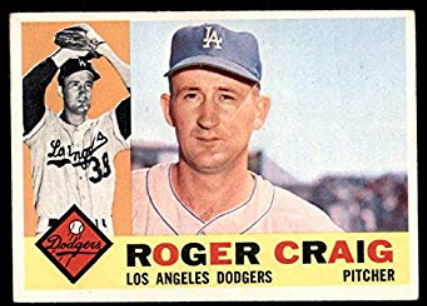

The Friday postponement meant a split admission day-night doubleheader was scheduled for Saturday, if the weather cooperated. In a strange twist of fate in the first game of day-night twin bill, future Giants manager, Roger “Humm Baby” Craig of the Dodgers pitched a six-hitter complete game for the 4-1 victory. Fast forward thirty years to the day, in 1989, Craig would watch his Giants beat the Dodgers 8-7 with a spine-tingling 5 run walk off in the bottom in the ninth. The losing pitcher in the 1959 game was hard-luck Johnny Antonelli, who was trying to win his 20th for the third time. Johnny never would gain that elusive 20th win in 1959.
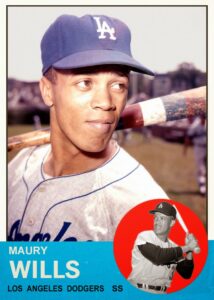
The Dodgers would score the decisive run on a freak error in their two run second inning. With one run in and two outs, future Giants pest rookie Maury Wills was on third and Joe Pignatano was on first. Johnny Antonelli delivered a ball to Roger Craig. The return throw by catcher Hobie Landrith sailed over Antonelli’s head! Wills raced home with the Dodgers second and decisive run.
The nightcap was a match-up of future Dodgers Hall of Famer Don “Big D” Drysdale versus young Giants lefty Mike McCormick. On the strength of a second inning Willie McCovey RBI single off Drysdale, who “Stretch” would terrorize his entire career, the Giants clung to a 1-0 lead into the top of the seventh inning. In the decisive seventh McCormick’s defense let him down when on a possible inning-ending double play second baseman Daryl Spencer dropped Jimmy Davenport’s throw as Don Demeter scored the Dodgers first run. After the drop, before the inning ended five Dodgers runs had crossed home. Dodgers 5 Giants 1.
The Giants fought back in the bottom of the 8th. But, after two runs had scored to narrow the Dodgers lead to 5-3, with two down Dodgers lefty reliever Danny McDevitt struck out the dangerous McCovey with two on. That was the final score and the Giants and Dodgers were tied for the National League lead with identical 82-66 records. The defending two-time National League champions Milwaukee Braves loomed a mere ½ game back. The final six games on the Giants schedule was going to be a nasty dogfight for survival!
Now for the lamentable story of the final game played at Seals Stadium. The pitching match-up featured Brooklyn Dodgers 1955 World Series hero Johnny Padres against Giants ace and 20 game winner “Sad” Sam Jones.
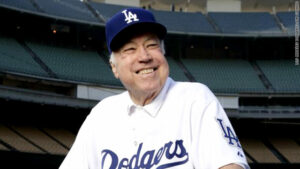
In the top of the second Jones tried to get a change up by Dodgers great Duke Snider leading off. The “Duke of Flatbush” crushed it over the right field wall, the ball crashed off the back wall of the bleachers. It would be the final home run hit at Seals Stadium.
In the top of the fourth Jones showed the effects of hurling 260 innings, both starting and relieving in 48 games. Maury Wills led off with a line drive single up the middle. After Dodgers catcher John Roseboro popped out to Felipe Alou in right, pitcher Johnny Podres lined a single to right and Wills scampered to third. Jones was done after two walks forced in Wills with the Dodgers second run. Saturday’s first game starter lefty Johnny Antonelli relieved and got out of the frame by inducing Wally Moon into grounding into a 3-2-3 (first base to home plate back to first base) double play.
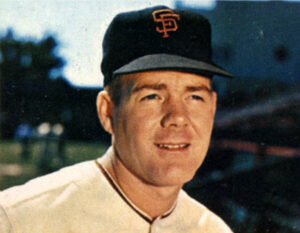
It was Dodgers 2-0 into the top of the seventh when with Al Worthington on the mound, the Dodgers tallied two more. The damage was done in this fashion. Gilliam walked leading off. Charlie Neal bunted Gilliam to second. Wally Moon walked and Duke Snider grounded a single into right field to score Gilliam with Moon going to third. Don Demeter lined out to Willie Mays in deep center with Moon scoring.
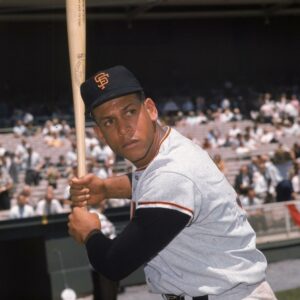
Trailing 4-0, the so far lifeless, bats of the Giants came to life in the eighth inning. Catcher Hobie Landrith worked Podres for a walk to lead off. Pinch hitter Jose Pagan fanned after working the count full. Eddie Bressoud struck out swinging for the second out. Rookie sensation Willie McCovey grounded to first baseman Gil Hodges who tossed the ball over Podres covering first as Landrith took third. With the dangerous Willie Mays due up, Dodgers manager Walter Alston brought in hard-throwing righthander Larry Sherry. Mays ran the count full before settling for a walk to load the bags. Orlando “Baby Bull” Cepeda, hitherto quiet in the series, lined a two-run single to left. It was 4-2 Dodgers and hopes grew in the 22,923 sellout crowd for a dramatic come-from-behind victory by the Giants. Alston went to the pen to bring in fireballing lefty, and future Hall of Famer, Sandy Koufax to face Felipe Alou. The inning ended when Alou flew out to center.

Any hopes of a dramatic Giants comeback were quickly extinguished when the roof caved in on the Giants in the top of the ninth. With Mike McCormick on the hill, Jim “Junior” Gilliam led off with a double. After retiring Charlie Neal on a grounder with Gilliam going to third McCormick walked Wally Moon. Giants manager Bill Rigney brought in Stu Miller, who was working for the third time in two days. Carl Furillo lifted a ground-rule double that scored Gilliam. Don Demeter ripped a two-run single to right on the first offering from Miller and it was 7-2 Dodgers. The Dodgers plated one more before Koufax grounded out to short to mercifully end the frame.
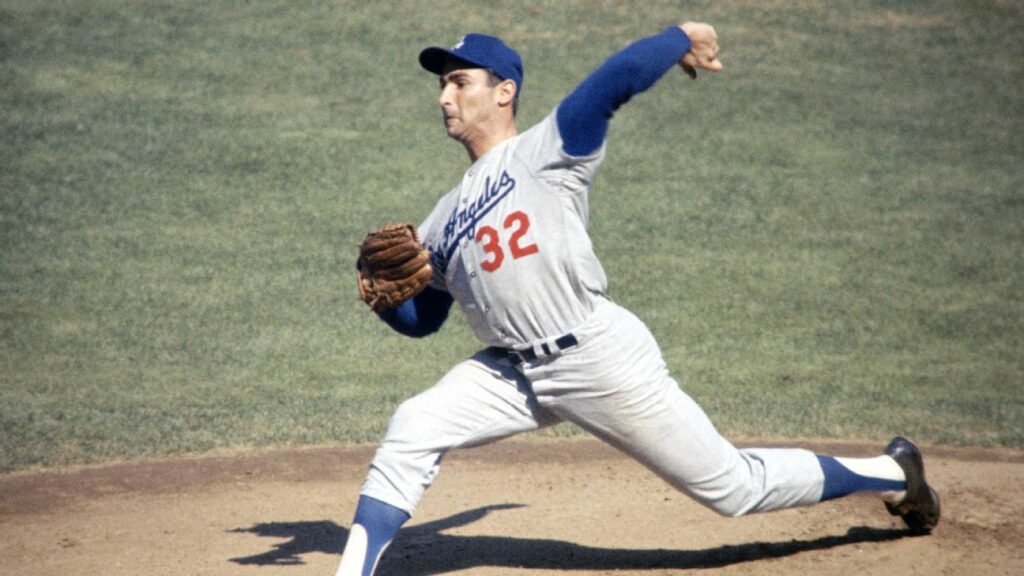
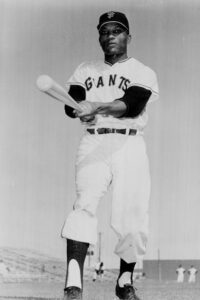
Hopes arose among the remaining die-hard optimists in the stands when Koufax walked the first two in the bottom of the ninth. Veteran Clem Labine took over for Koufax and promptly walked Landrith to load the bases with no outs. Rigney sent up powerful Leon Wagner to pinch hit for Miller. The left-handed batting Wagner had hit a walk-off grand slam against these same Dodgers in May. If he could do it again it would be a ballgame again. The optimists in the crowd edged closer to the edge of their seats and those close to the exits lingered to watch the powerful “Daddy Wags” take his hacks. Wagner went down swinging. But, the bags were still juiced and the top of the order was up.
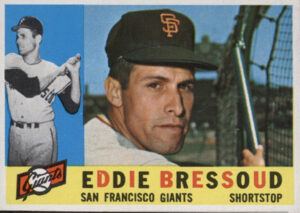
When Labine induced Eddie Bressoud to ground into a 4-6-3 (second to short to first) double play the Dodgers had swept the three-game series and the Giants found themselves trailing their archrivals by a game. It was a depressing way for Seals Stadium’s glorious history to end.
The managers insisted the pennant race was not over yet. Here’s a few quotes after the game. Giants skipper Bill Rigney insisted,”They haven’t heard the last of us yet. If we beat the Cubs in Chicago tomorrow, things will look different. We’re not out of this. I remember in 1951 when we were five games out with nine to play. We caught Brooklyn at the wire and won the pennant in the playoff.” Brave words designed to inspire his troops. But, the Giants had suffered a tremendous blow psychologically!
For Rigney it was a manager’s nightmare. In little more than 27 hours he had seen his league-leading Giants collapse at the plate, in the field, and—to a slightly lesser degree—on the hill to blow all three games of a vital series with the once all-but-eliminated Dodgers.
Alston trying to damp down the enthusiasm of his players in the locker room by shouting to them, “The Giants aren’t out of it yet. We’ve got to keep going. This is no time for a letdown.”
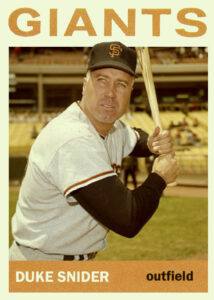
Duke Snider said, “The Giants humiliated us last year, beating us 16 times. This was a must series for us, and we told ourselves remember last year.” Ironically, “The Duke of Flatbush” would end his Hall of Fame career with the Giants five years later in 1964.
Things didn’t improve for the Giants, there followed two extremely painful consecutive walk-off losses to the Cubs at Wrigley Field on to a four loss, one win final road trip. Sadly, there would be no World Series at the incomplete Candlestick Park. The Dodgers beat the Braves in a playoff. So, instead of Candlestick Park, the Los Angeles Memorial Coliseum hosted the 1959 World Series. The final slap in the face of San Franciscans was the Dodgers winning the World Series over the Chicago “Go Go” White Sox!!

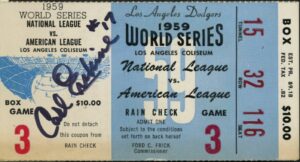 In a shocking look at how far baseball has changed economically in the 60 years since, the Giants printed World Series tickets for the yet to be completed Candlestick Park – the price for a lower deck reserved seat to the 1959 World Series at the new “Yard” – $7! The Dodgers charged a mere $10 for a box seat!
In a shocking look at how far baseball has changed economically in the 60 years since, the Giants printed World Series tickets for the yet to be completed Candlestick Park – the price for a lower deck reserved seat to the 1959 World Series at the new “Yard” – $7! The Dodgers charged a mere $10 for a box seat!
Within two weeks of the final game they began the sad task of tearing down Seals Stadium. On October 5th 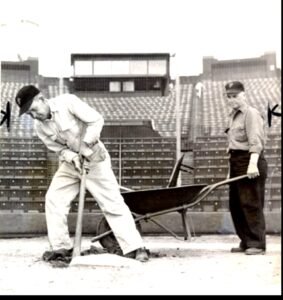 1959, a typical beautiful warm autumn day in San Francisco, the crew went to work dismantling the park. The men began ripping out the over 18 thousand wooden seats and stacking them in the outfield under a tarpaulin to await a buyer. Home plate was unceremoniously dug up to be transplanted in the new Candlestick Park.
1959, a typical beautiful warm autumn day in San Francisco, the crew went to work dismantling the park. The men began ripping out the over 18 thousand wooden seats and stacking them in the outfield under a tarpaulin to await a buyer. Home plate was unceremoniously dug up to be transplanted in the new Candlestick Park.
Jerry Warner, a spokesman for Swinerton & Walberg, the construction company that had built the ballpark 29 years before, captured the funeral-like mood by muttering, “It’s a shame, a doggone shame. It’s still a beautiful park.”
To make the mood even more excruciating, a transistor radio loudly blared game 4 of the World Series from Los Angeles, a bitter reminder of the final disappointing series played at the old park.
A few 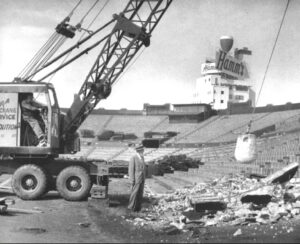 months later the steel wrecking ball began smashing the old park to smithereens. The concrete was so sturdy that it took a long time for that heavy solid steel ball to reduce the stadium to a pile of rubble.
months later the steel wrecking ball began smashing the old park to smithereens. The concrete was so sturdy that it took a long time for that heavy solid steel ball to reduce the stadium to a pile of rubble.
Paul Fagan, the majority owner of the Seals, donated a few items, the turnstiles and the centerfield flagpole, to Candlestick Park. As soon as the final game ended on September 20th the turf was dug up and transplanted at Candlestick when it was optimistically believed the 1959 World Series would be held at “The Stick.”
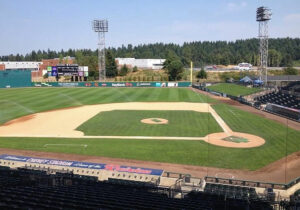
The wooden seats and light towers were loaded onto a ship and taken to Tacoma’s Cheney Stadium. The Seals Stadium seats are in use to this day! Cheney Stadium was built in 42 days after the Giants committed to moving their Triple-A affiliate to Tacoma from Phoenix for the 1960 season.
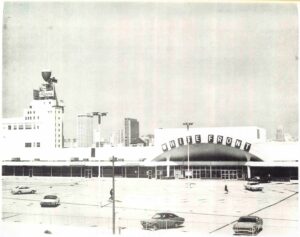 After sitting empty for over six years, in 1966 the Interstate Department Stores Inc. announced that they would acquire the site of Seals Stadium to build their biggest yet White Front discount department store. The site at 16th & Bryant Streets had sat as a windblown dusty wasteland since the wrecking ball had finished its work in 1959. The store would be two levels and have parking for a thousand cars.
After sitting empty for over six years, in 1966 the Interstate Department Stores Inc. announced that they would acquire the site of Seals Stadium to build their biggest yet White Front discount department store. The site at 16th & Bryant Streets had sat as a windblown dusty wasteland since the wrecking ball had finished its work in 1959. The store would be two levels and have parking for a thousand cars.
Today the Potrero Center, anchored by a Safeway, occupies the former site of Seals Stadium. There is one familiar place remaining from the baseball days of 16th & Bryant Streets, the venerable Double Play bar. First opened in 1907 the saloon was a favorite hangout of Seals players after the games.
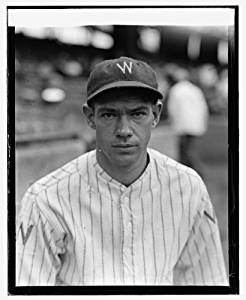
There is a colorful story, allegedly true, that a veteran Seals pitcher in the 1930’s didn’t wait until the game ended to sneak across the street to the Double Play. Noble Winfred Ballou, known by his nickname as “Old Pard”, used to be a regular at the Double Play. “Old Pard” would overindulge on occasion at the Double Play and could be found sleeping it off on the sidewalk in the morning. A bat boy claimed that sometimes “Old Pard” was missing in the bullpen and he would be sent to fetch “Old Pard” at the Double Play. “Old Pard” would hurry back to the bullpen to warm up and do his duty for the Seals.
My father and both grandfathers long mourned the demise of Seals Stadium. To many San Franciscans the Seals and Seals Stadium was where “real” baseball was played. Native son “Lefty” O’Doul and famed Chronicle columnist Herb Caen both campaigned to save Seals Stadium. By adding a second deck the capacity could have been nearly doubled, bringing it up to big league standards. But, Giants owner Horace Stoneham insisted on a new ballpark with parking for thousands of cars as a condition of moving to San Francisco, something not possible in the neighborhood around Seals Stadium.
I can’t end this remembrance of the final game at Seals Stadium without relating a vivid memory of mine. My parents moved to Sunnyvale when I was two years-old. Both of my grandparents remained living in the Mission District in San Francisco only a 15 minute walk from Seals Stadium. Our large family visited our grandparents very often.
Our drive home to Sunnyvale was invariably at night. We got on highway 101 right by Seals Stadium. Once on the elevated 101 the Hamm’s brewery, next door to Seals Stadium, came clearly into view. The colorful neon sign high on the roof of the brewery was in the shape of a glass of beer. The sign would start out with the glass full, including a head on the beer. Slowly the beer in the glass appeared to empty as the lights went out progressively. Us kids were delighted by this sign and I can still see vividly the beer glass slowly emptying as if an invisible giant (pun very much intended!) was drinking it down! Every San Franciscan of a certain age will remember that Hamm’s sign, despite my inadequate attempt to describe it in words.
Here’s many exclusive unpublished fine photos of that final sad game at Seals Stadium, courtesy of my dear friend Steve Okano. Enjoy!
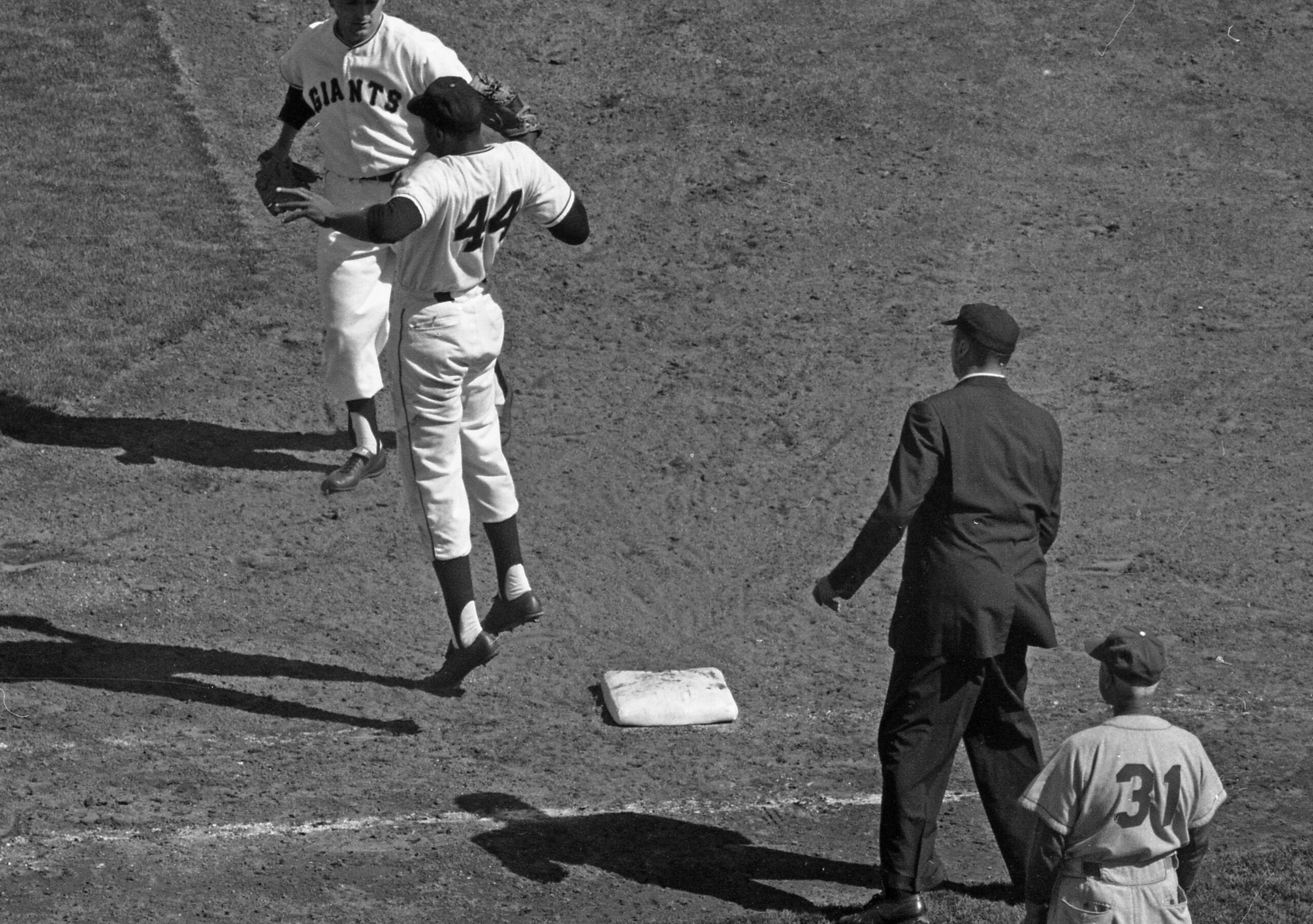
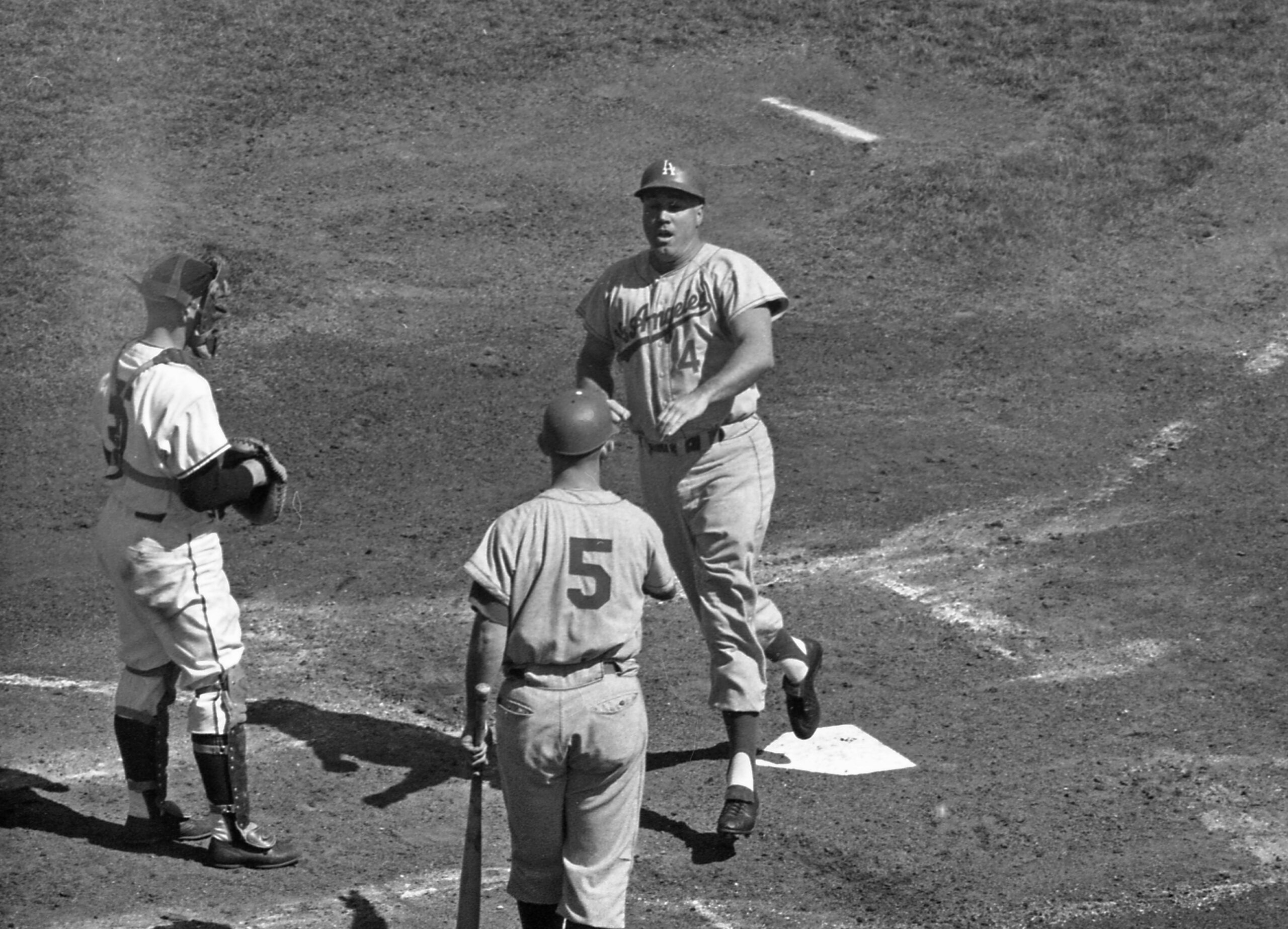
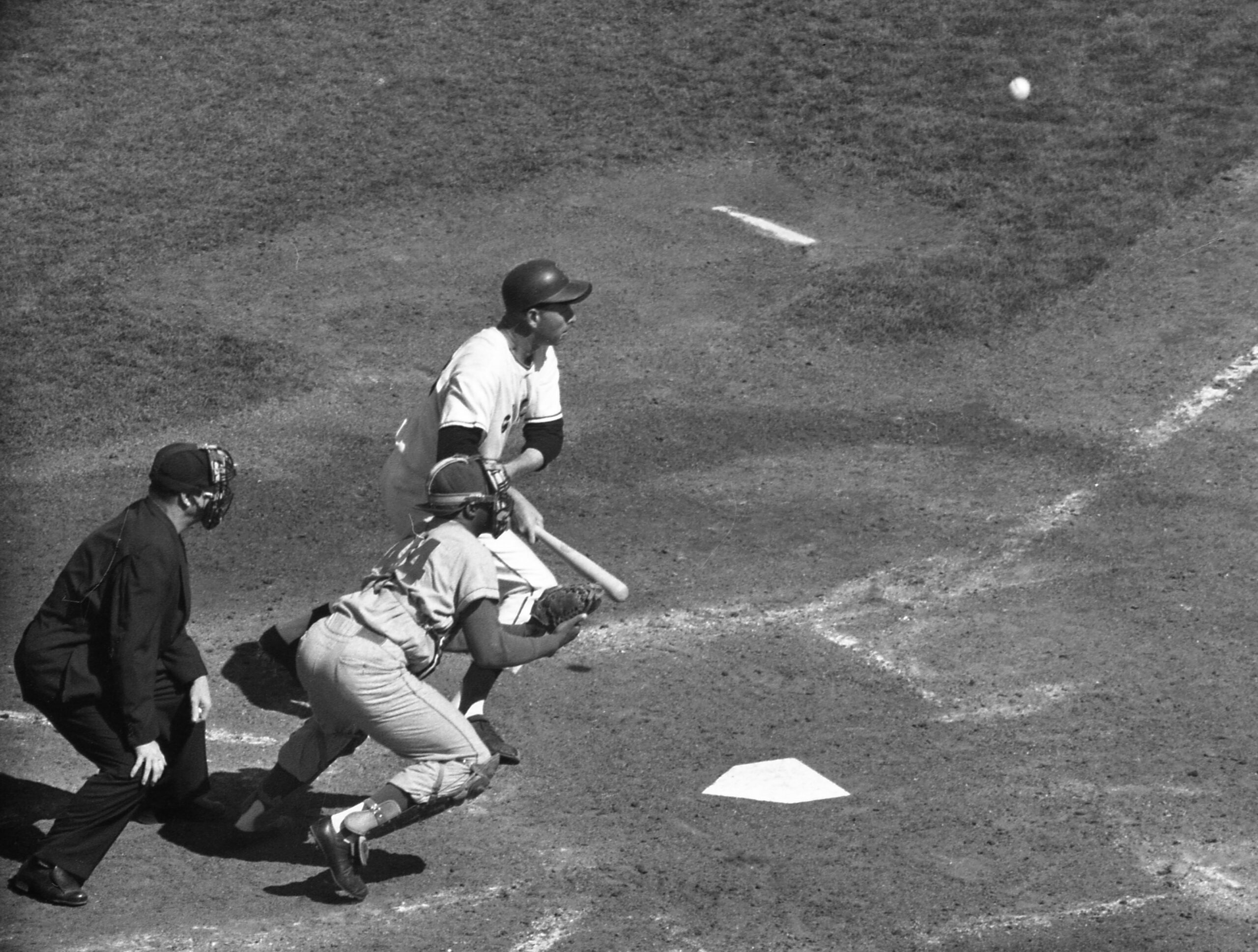
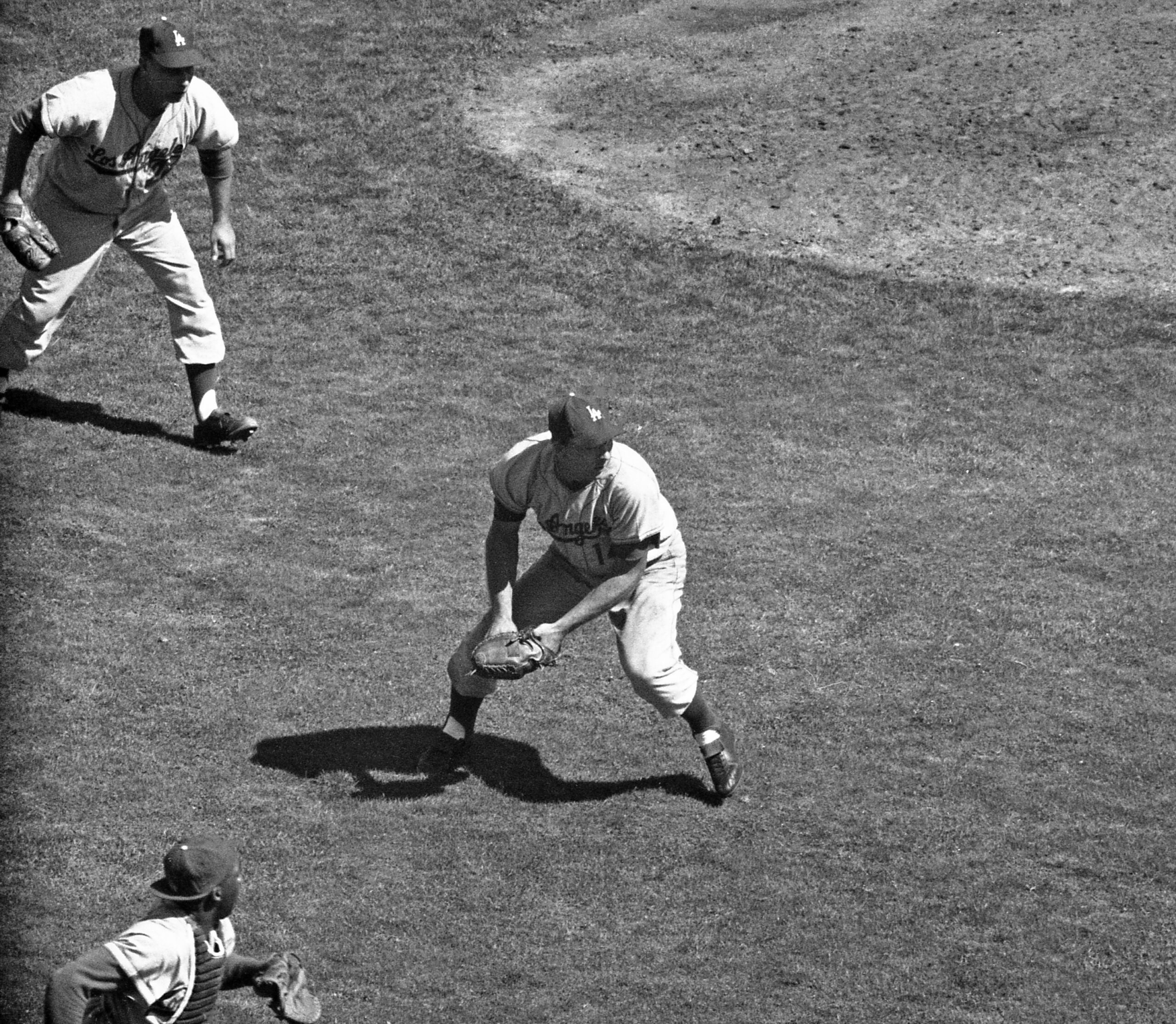
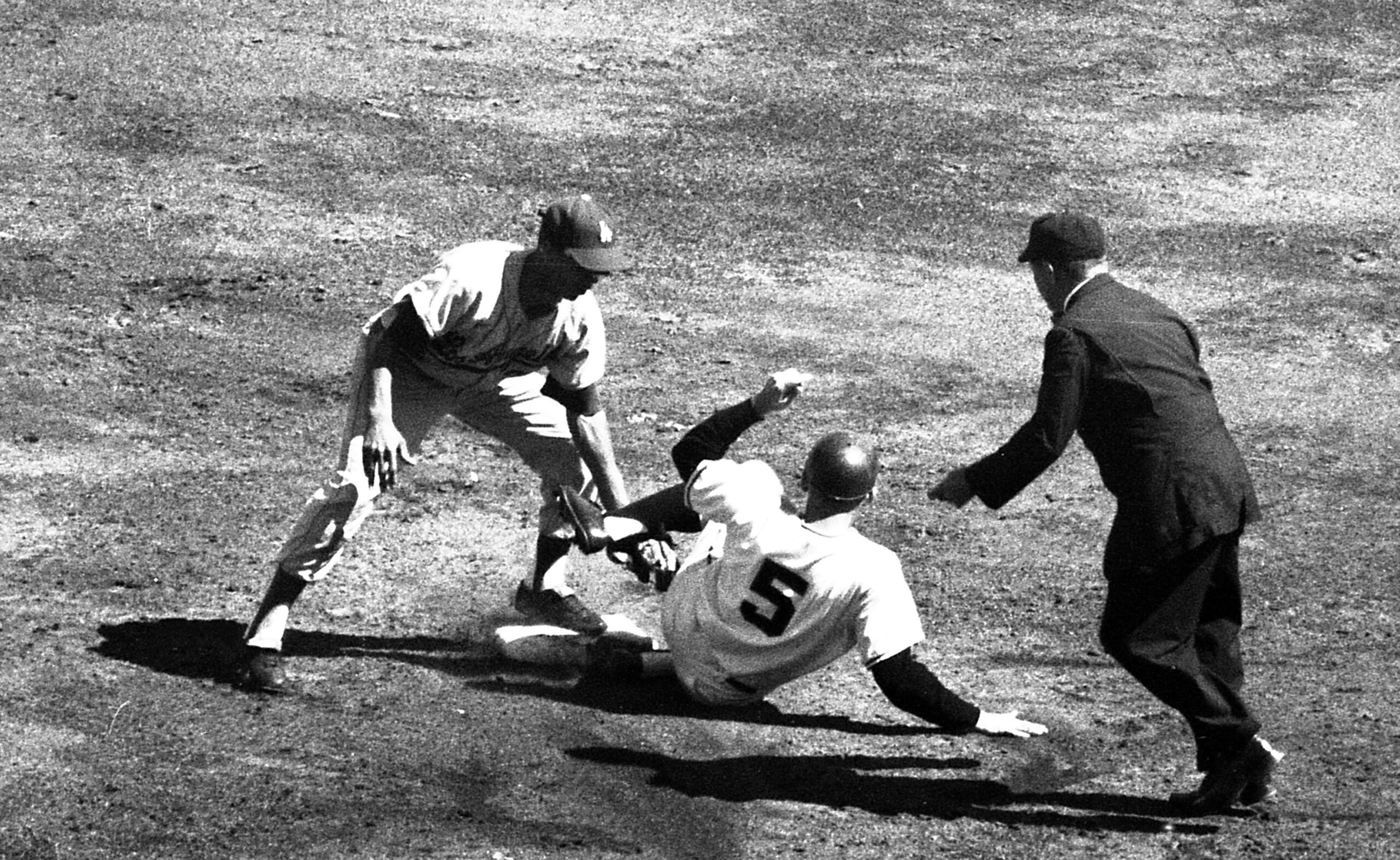

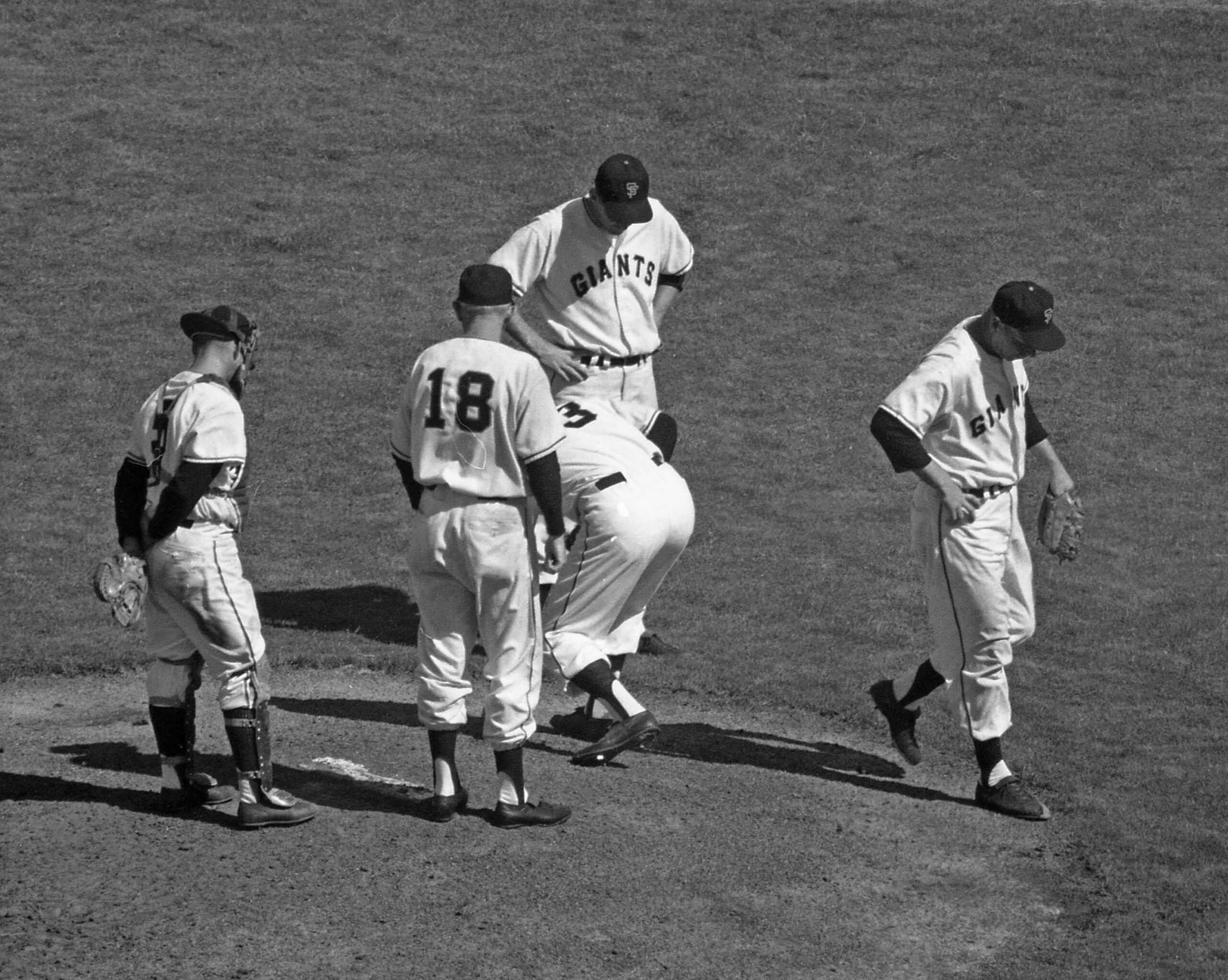
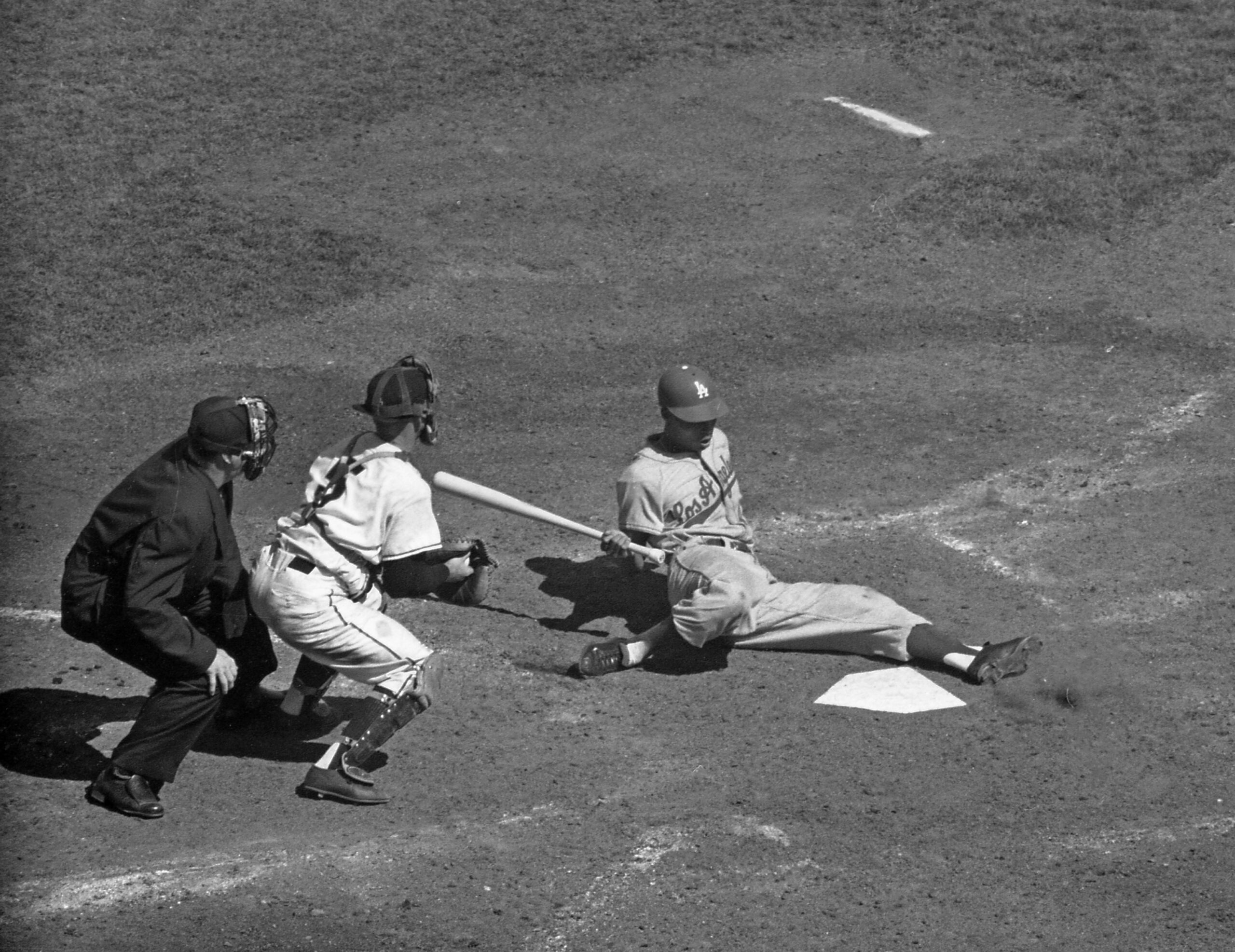

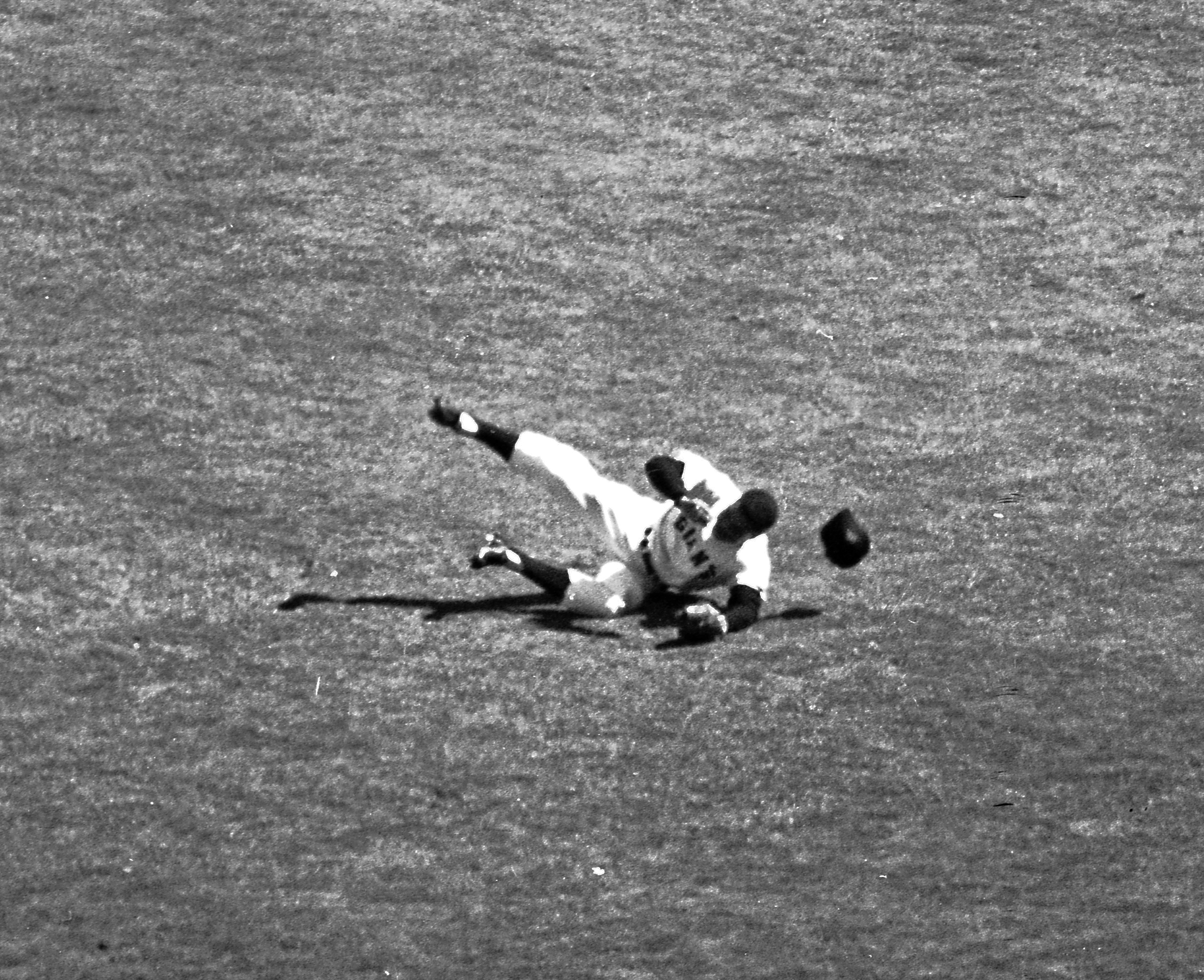
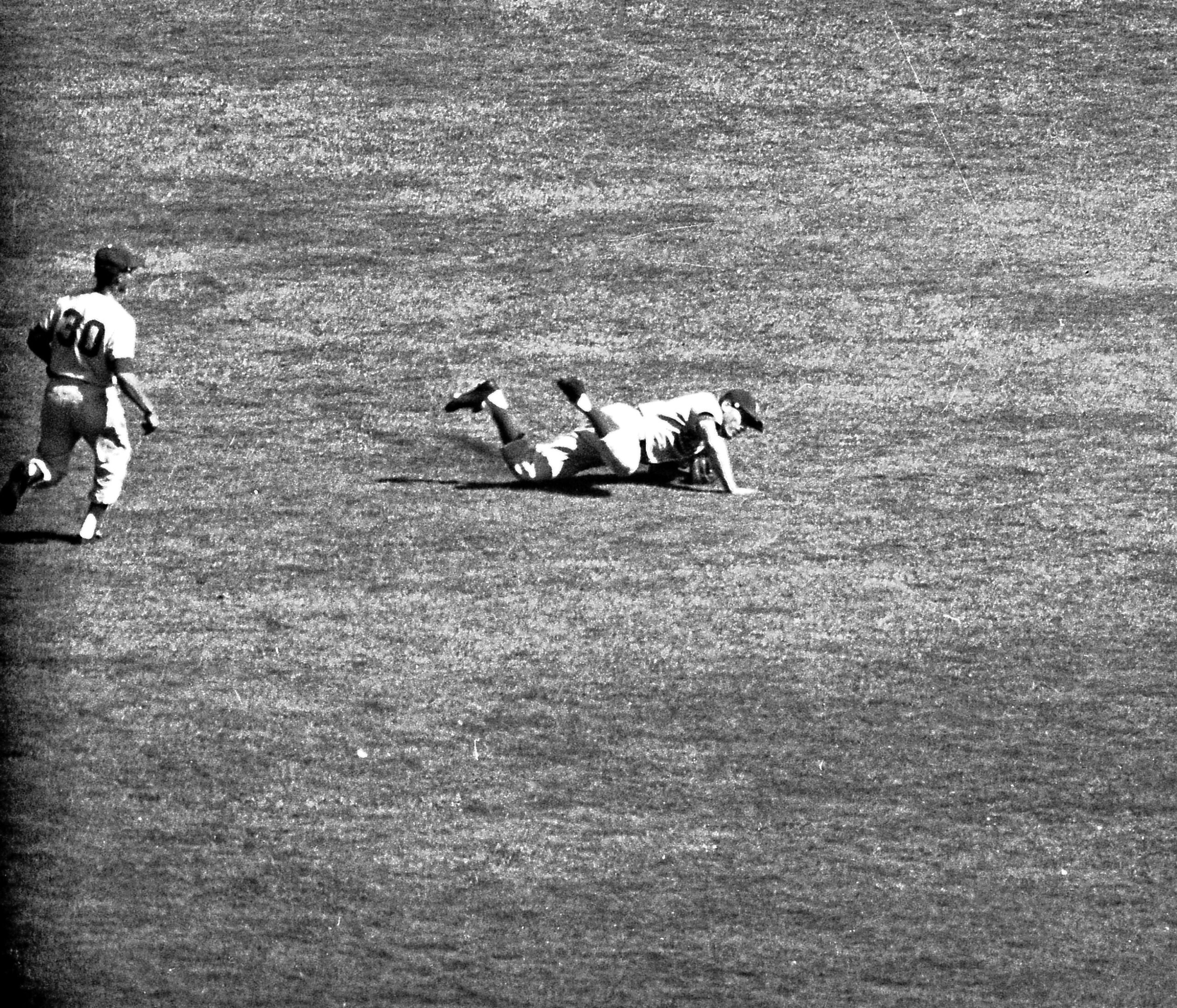

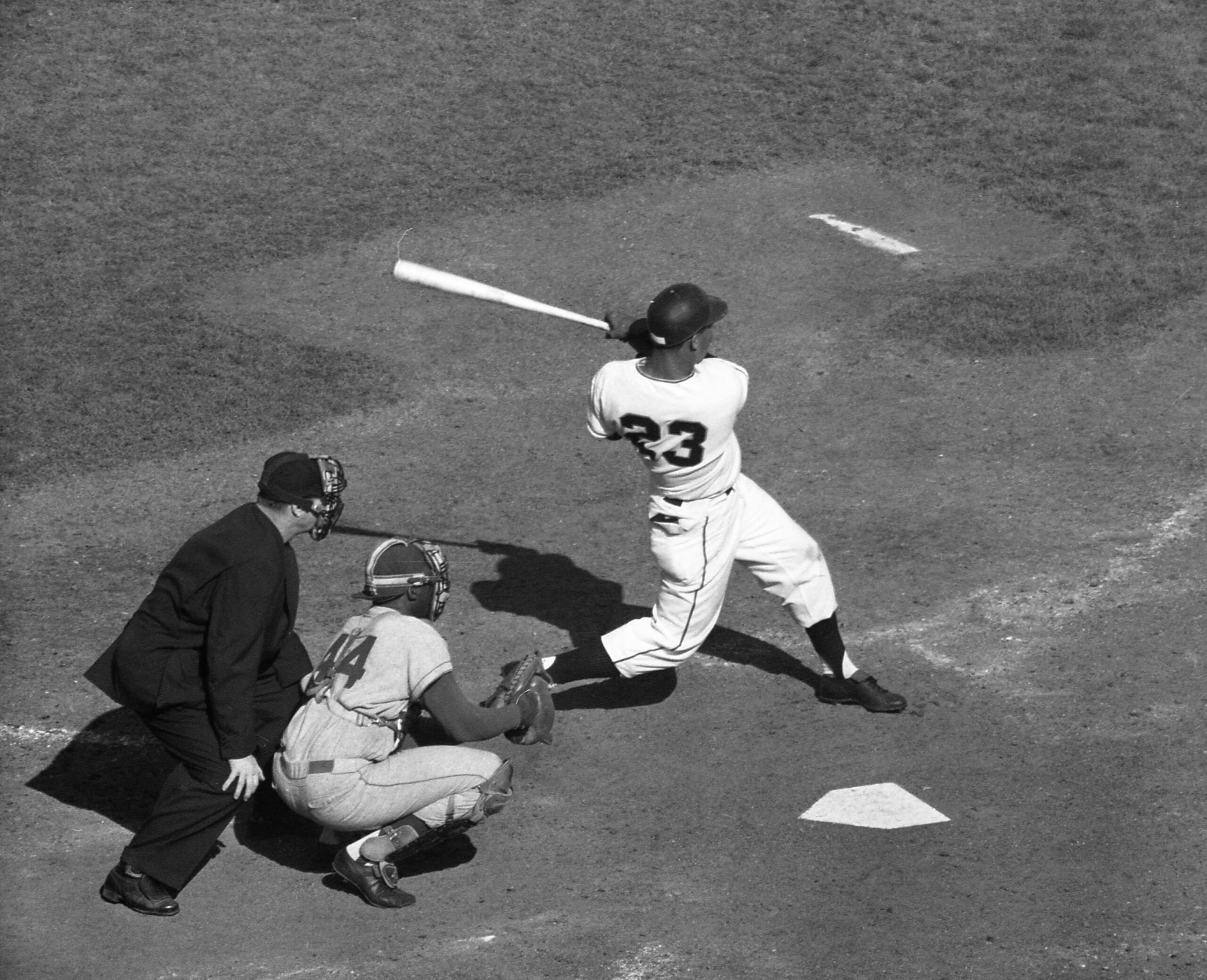
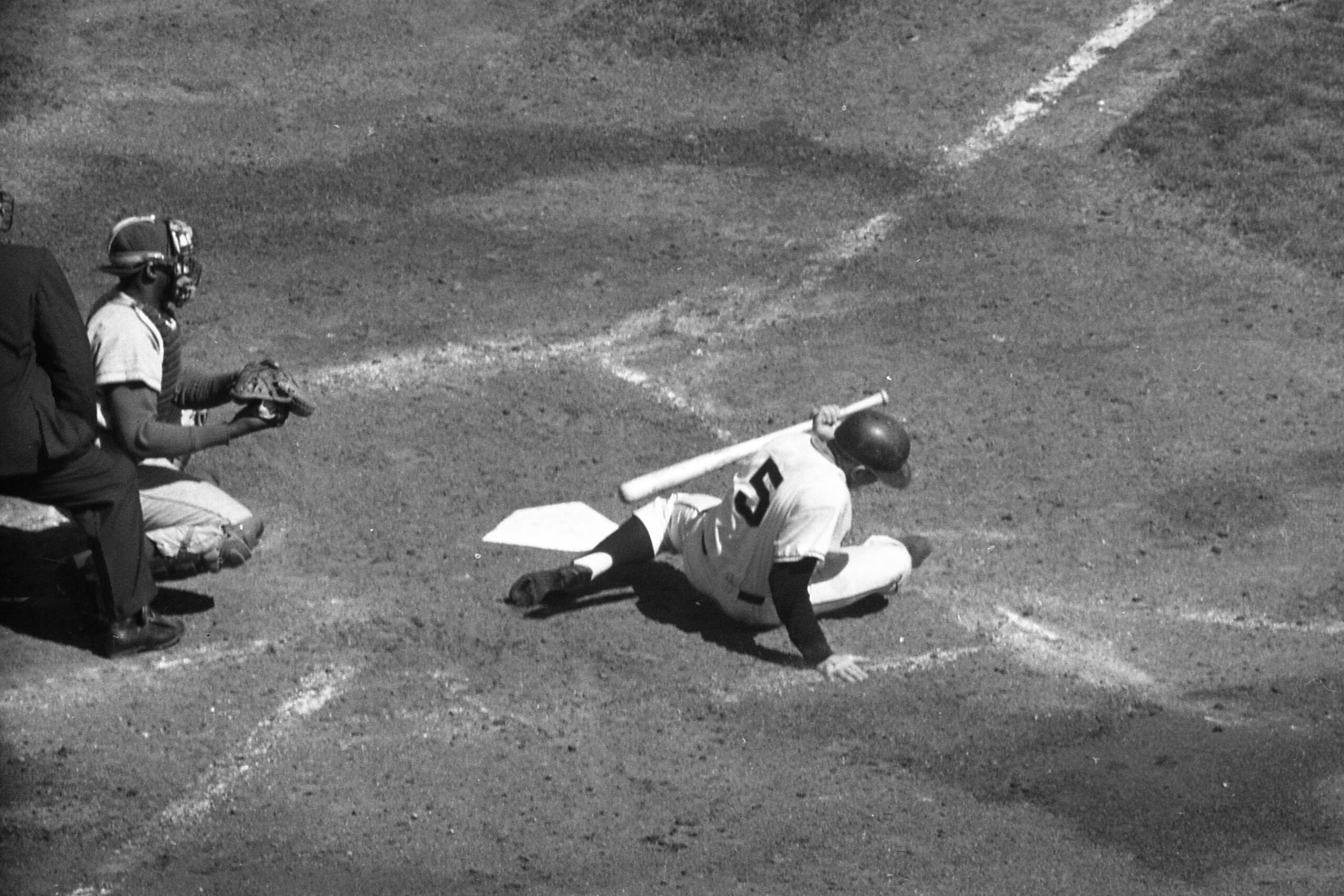
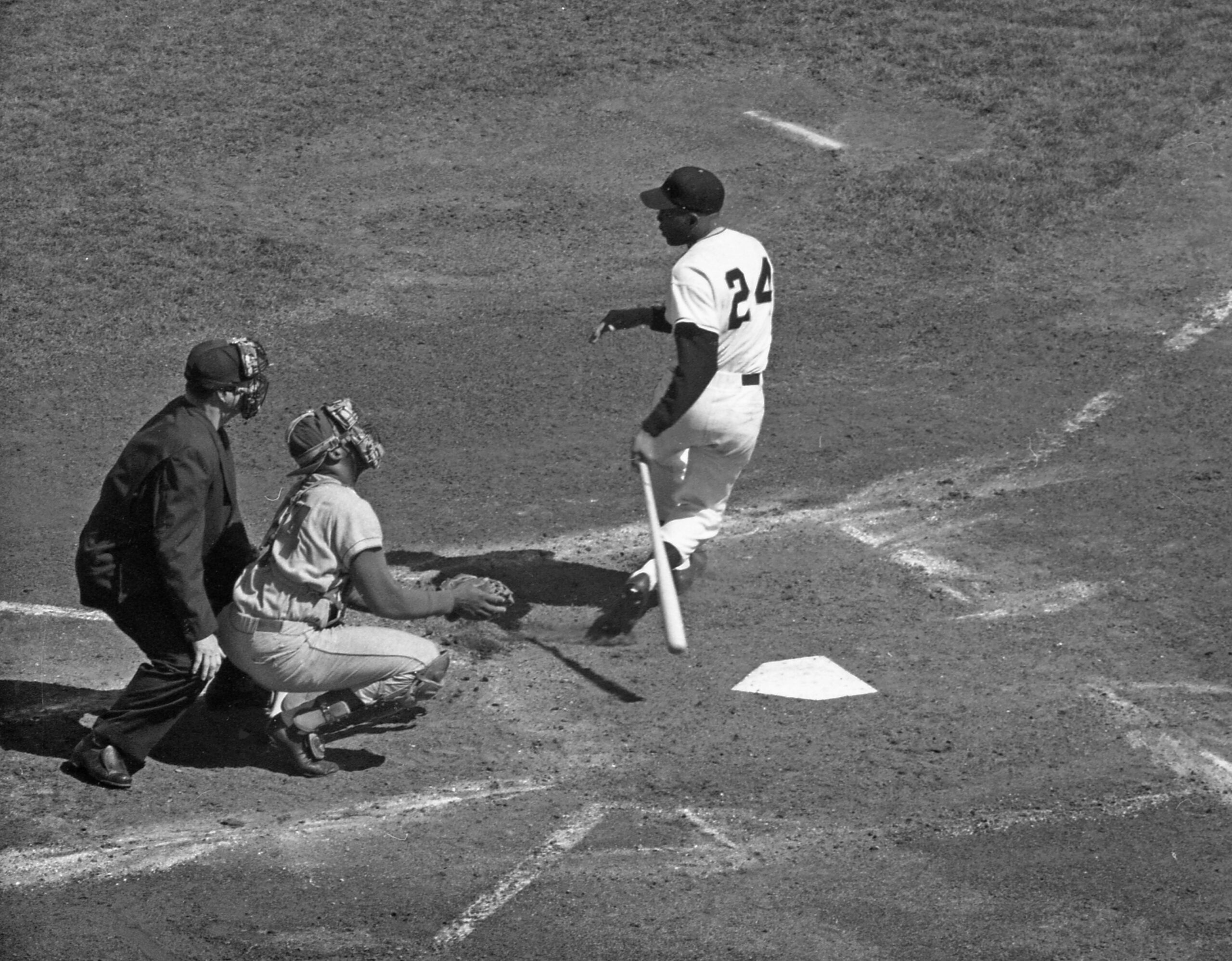
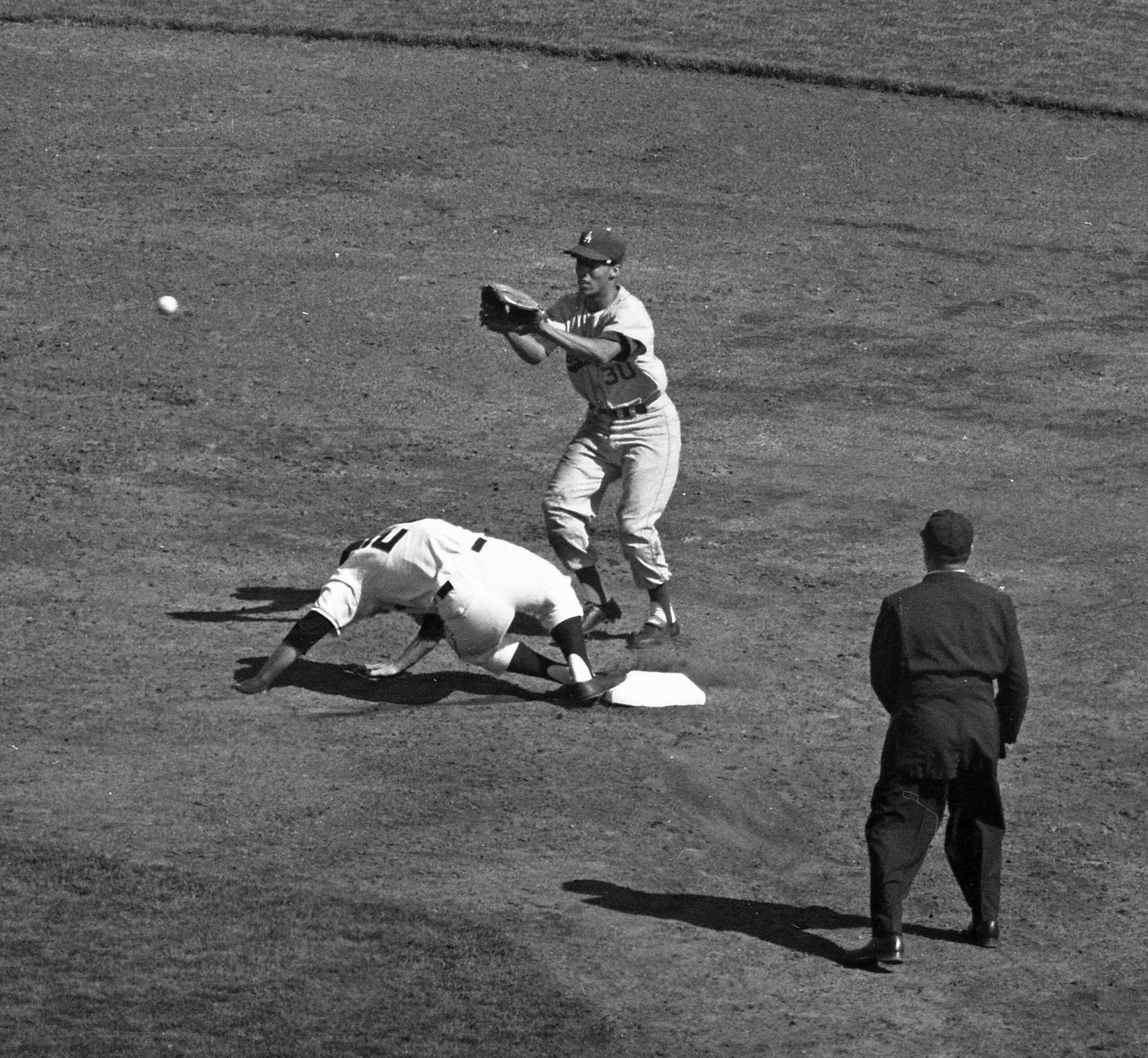
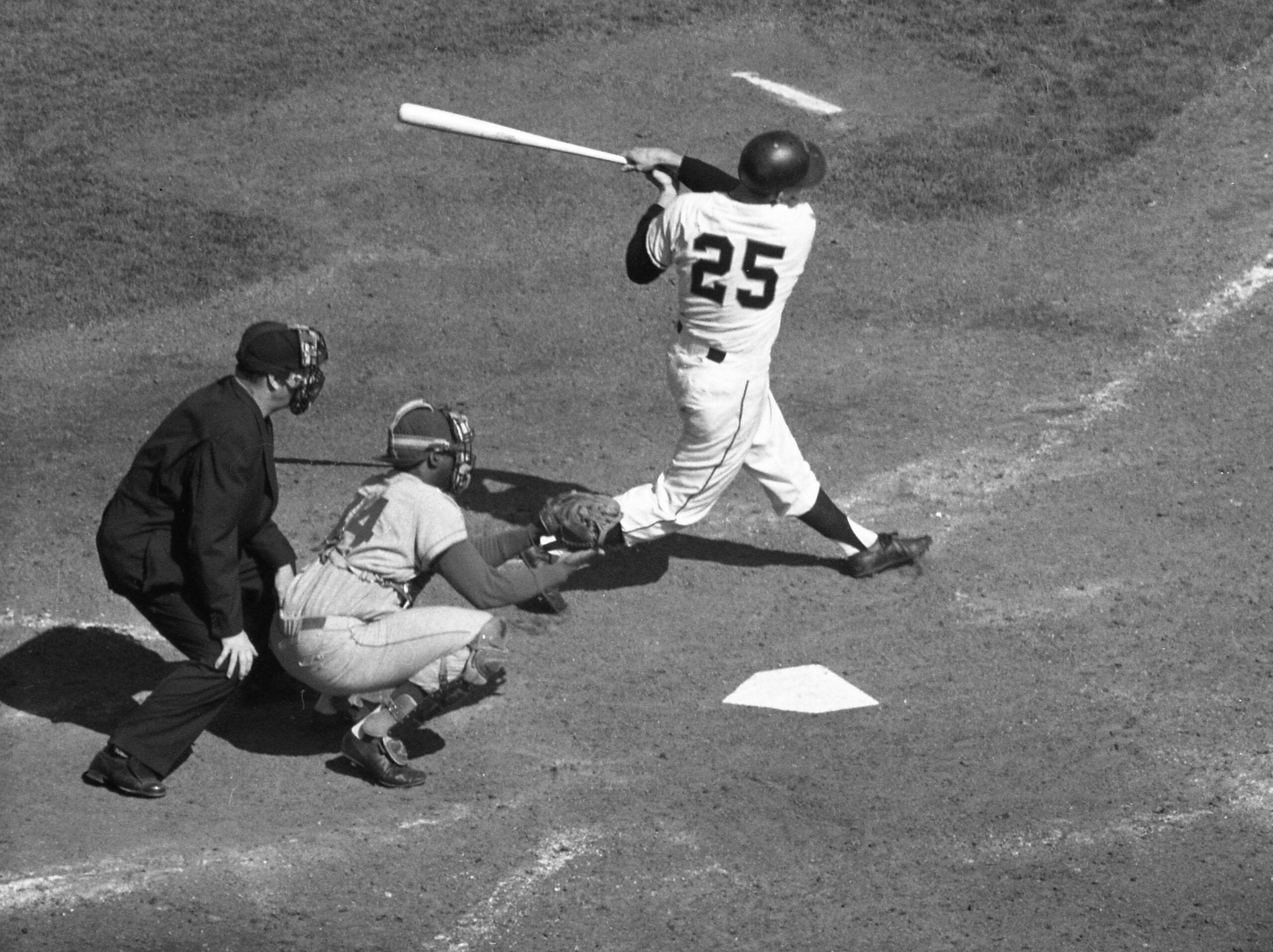
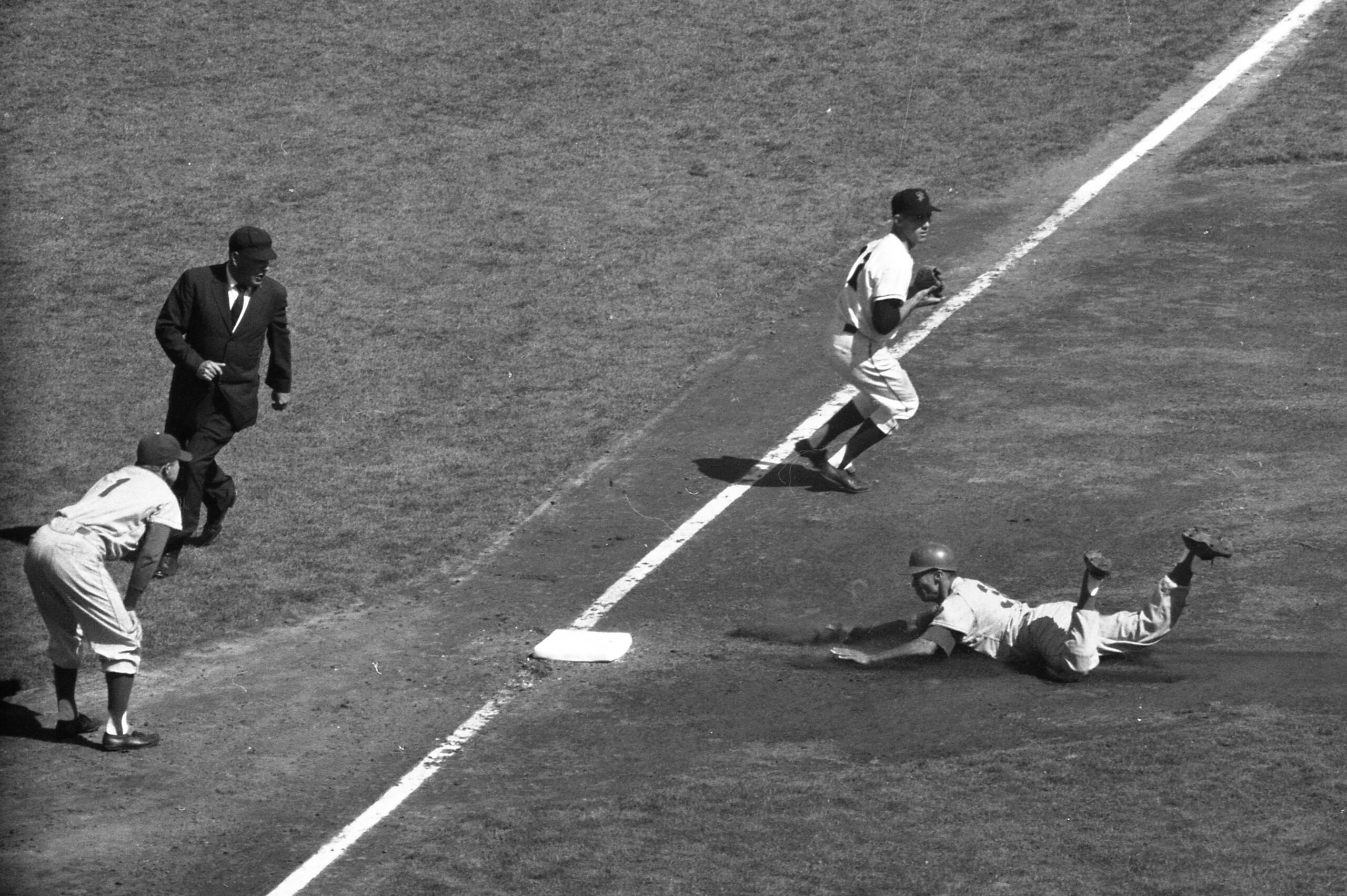
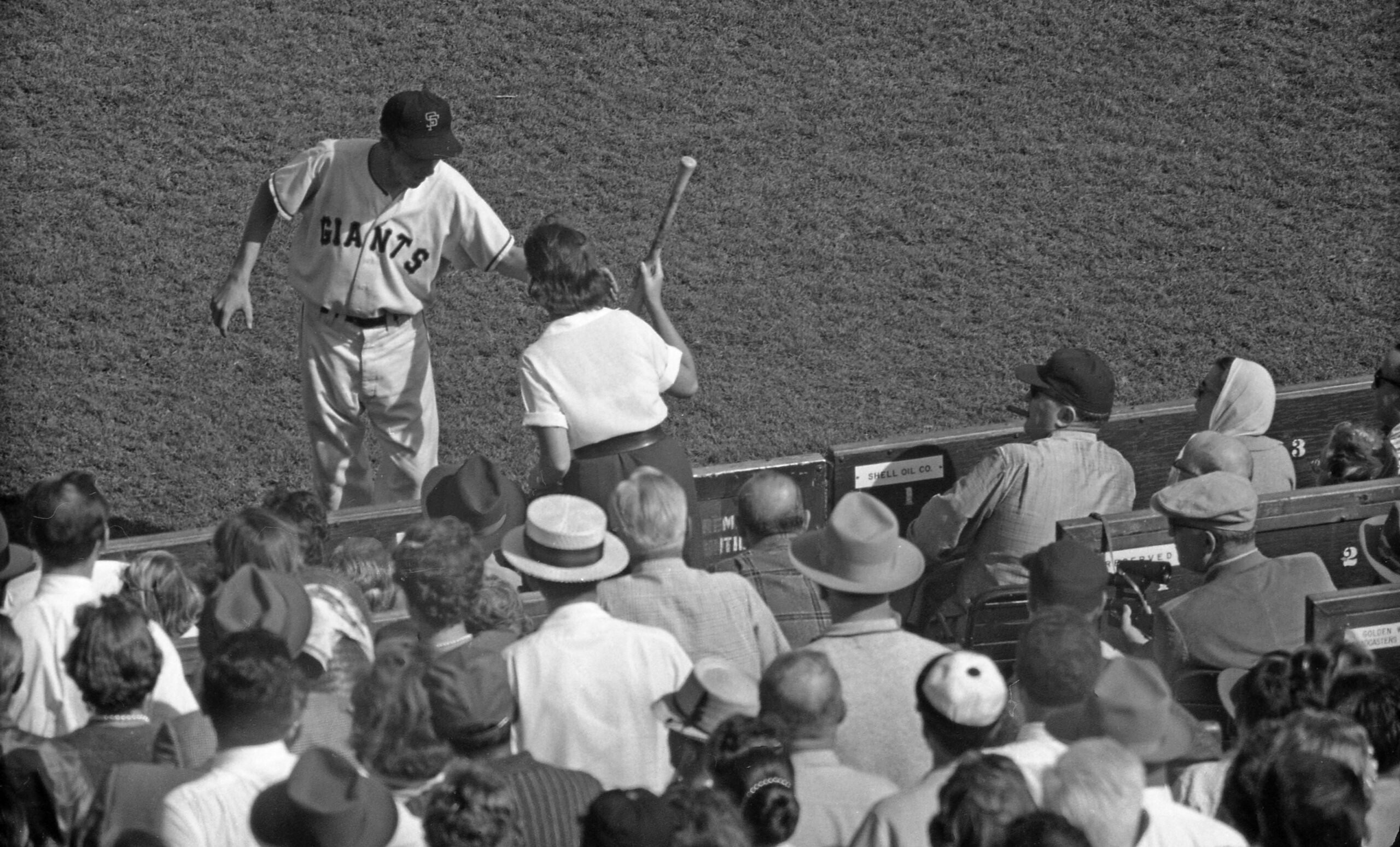
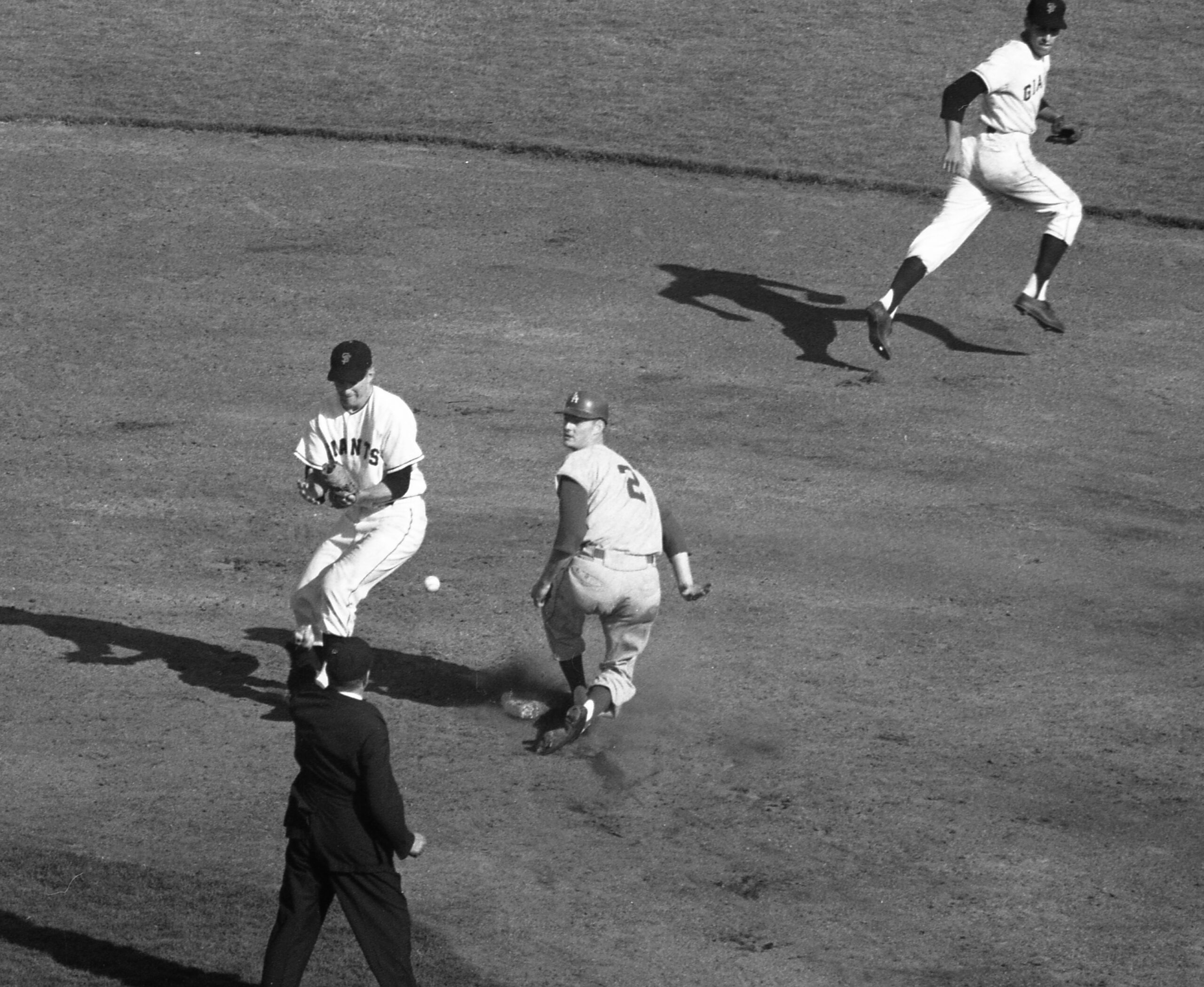
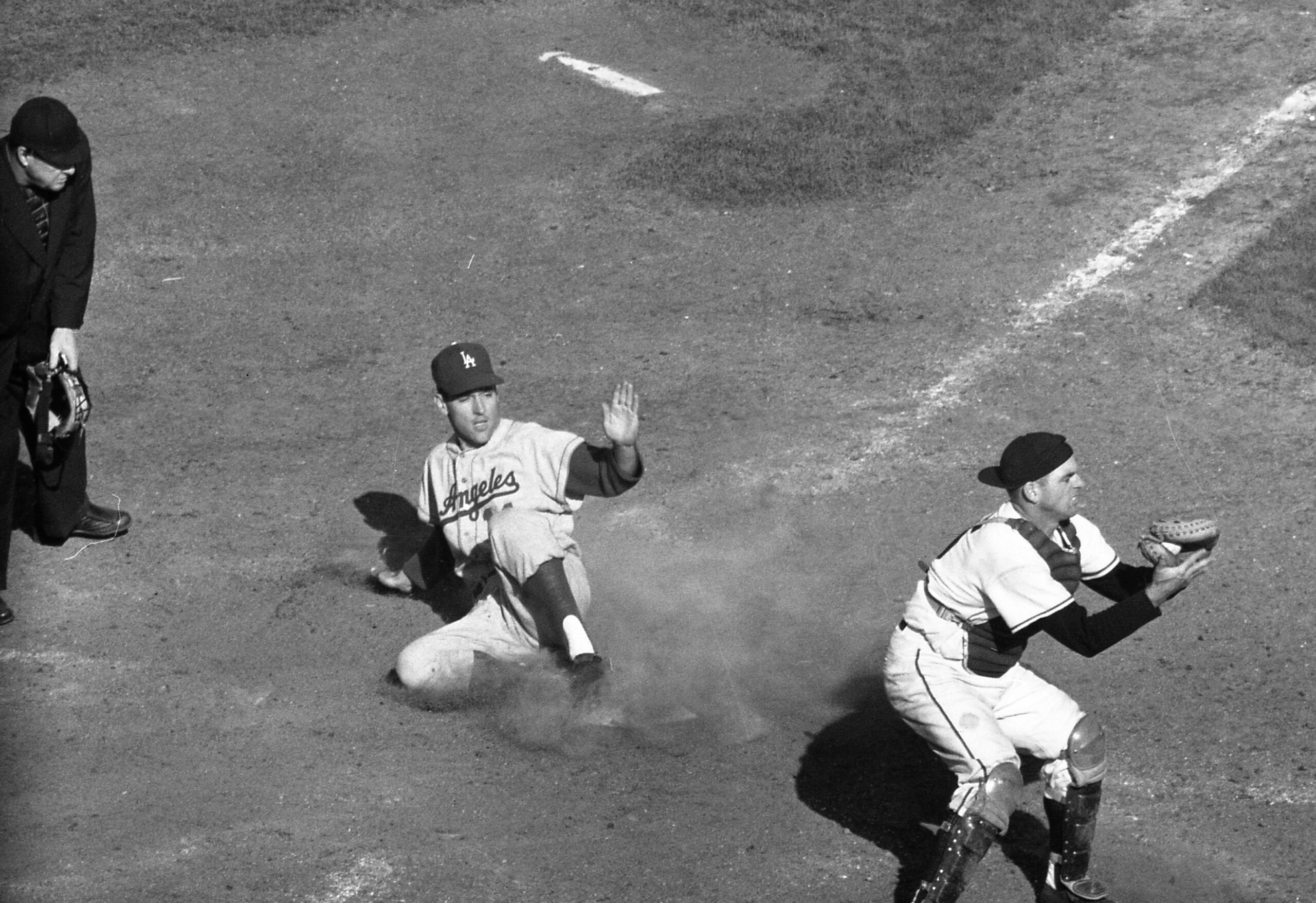

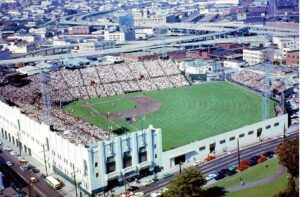
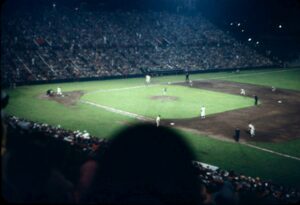
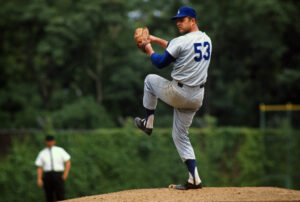
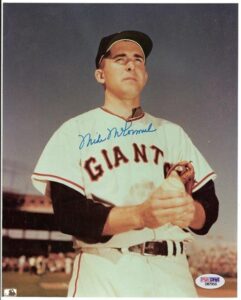
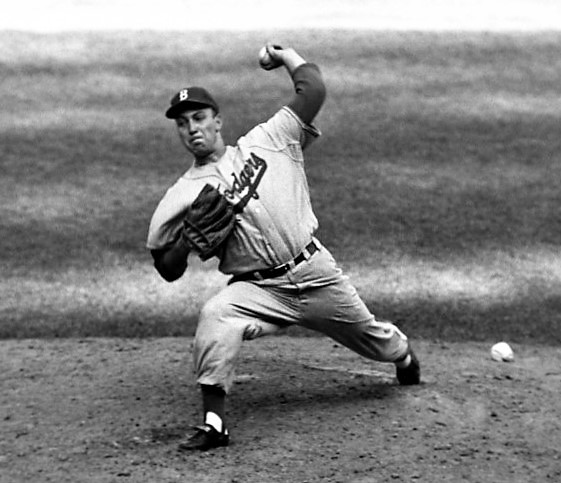

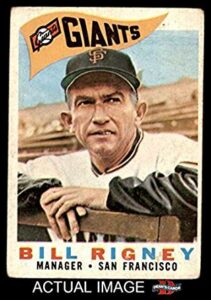
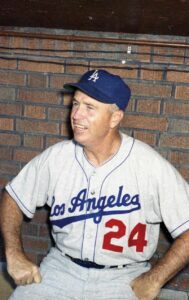
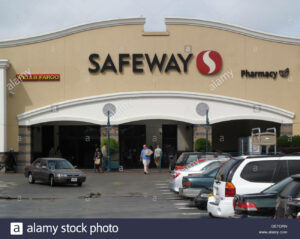
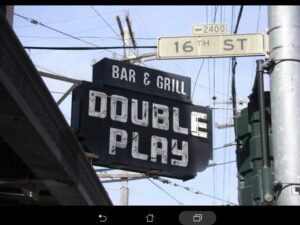
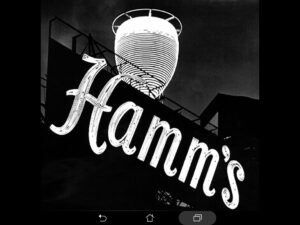
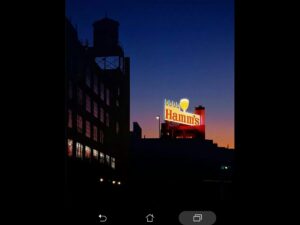
What a truly wonderful piece Chris, written so vividly that it makes one feel they were there. Thank you for sharing such an integral piece of Giants history, you have such a way with words, I truly felt as though I had been transported back in time. I enjoyed every magical moment, Go Giants!
Excellent read! Being a Giant fan from NYC, I never knew the history of Seals
Stadium. Wonderful job depicting the details. Love the pictures. Glad I was too young to experience the last weekend at Seals. That was a lost weekend!
As a late to the plate PCL fan who loved the Angels and Wrigley Field, I empathize greatly with your emotions in this piece. I, too, was introduced to the big leagues in 1958; my grandfather took me to watch the downtown parade to City Hall by both teams and then on to the Coliseum for the Dodgers’ 6-5 home opener win (the last time they were at .500 that season).
A great play by play of the rise and fall of both the San Francisco Giants & Seals Stadium over the final weekend home series in 1959. I knew about the pennant races between the Giants, dodgers, & braves in 1982 and 1993, but not this one. Thanks again Chris for writing and sharing this story of this time of transition in San Francisco baseball.
Thanks Matt! Yes, the Giants had a horrendous September after being in first for much of the season. The disappointment of that season is my first vivid memory of baseball, I was 7!